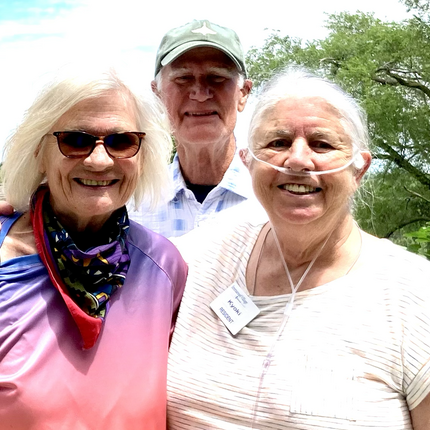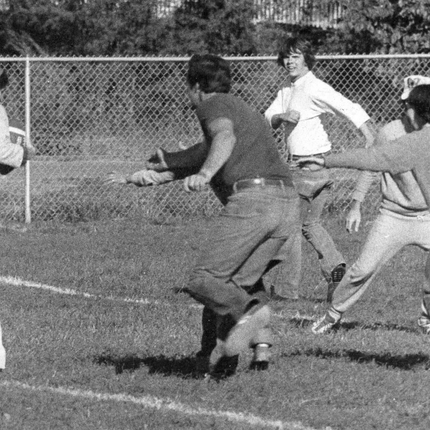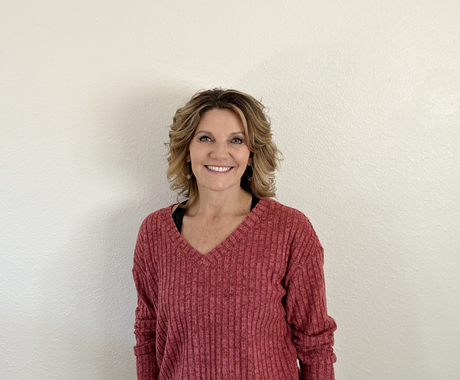By Gene Severens, Center for Rural Affairs (on staff from 1978 to 1993)
While many Center for Rural Affairs' old-timers may not recognize the name Chris Roberts, she played a critical role in changing the direction of the Center in the late 1970s. Most of the work in the early 1970s focused on policy advocacy and muck-raking journalism. But Chris changed this—at least for me.
Her unannounced visit to the Center one day nudged us to realize the value of direct client assistance, and how this hands-on client work was not only important to the Center's mission but also informed and complemented our advocacy work.
Chris died in December, and a mutual friend asked me to write up my memories of her. During that effort, I found myself regarding Chris as the Center's "first client" and how my encounter with her launched the Center into years of direct farmer credit advisory work, which, in turn, by the end of Farm Crisis in the late 1980s, set the stage for the Center's first direct lending effort—the Rural Enterprise Assistance Program (REAP).
First encounter
My first encounter with Chris was in late 1978. I was in my first year at the Center, having just completed law school. I was hired along with former VISTA volunteer Chuck Hassebrook through a grant from the Campaign for Human Development for the Small Farm Advocacy Project. While I was excited at becoming the Center’s first staff lawyer, I was painfully aware of how inexperienced and uninformed I was about agricultural policy and economics. Feeling pressure, one day I heard Center Office Manager Jere Maslonka claim, ”Now that we have our own lawyer, we’re really going to get some things done.”
A city boy from Omaha, I began to absorb talk about the “structure” of agriculture, and, in my early research, I began to discern the all too common pattern of how high-sounding pro-family farm laws passed by Congress during the Depression years had, by the 1970s, strayed from their original purposes. I learned how various U.S. Department of Agriculture administrative agencies, along with federal tax laws, had re-aligned their services away from beginning and family-size farms toward larger and corporate operations. I also learned how difficult it was to detect, document, and challenge USDA's slow erosion from its original purposes.
I noticed that one federal agency in particular seemed a promising place to start my advocacy work—the (now defunct) Farmers Home Administration (FmHA). FmHA loans, both ownership and operating, were critical to low-income, beginning farmers who had little access to bank credit. FmHA stood as a gatekeeper to farming as the only way a low-equity, beginning farmer could get started in the capital-intensive business of farming. I noticed the curious term “limited resource farmer,” and I learned that a recent congressional amendment called for FmHA to make low-interest, deeply subsidized loans to economically disadvantaged farmers, including beginning, minority, and women farmers.
Then one day, unannounced, Chris Roberts and her husband, Charlie Eliason, walked into the Center’s Walthill office. Chris spoke with Jere, explaining that she wanted to talk to someone about getting a loan to start farming. Chris was well-spoken and had a big smile. I noted Charlie had very little to say except that he had a good job in Omaha. That’s when I realized that Chris was a woman and a beginning farmer—a “two-fer” in FmHA’s definition of a limited resource farmer.
Growing excited, I invited them to sit down. I told her everything I knew about the limited resource farmer program. Chris understood quickly. I photocopied some relevant FmHA Limited Resource Farmer regulations for her and coached her on things she could consider saying to her FmHA county supervisor when she went to apply. Short story: Chris applied, got two loans (both operating at 5% and ownership at 3%) and bought her farm in Yutan, which she farmed for 10 years.
She called a few weeks later to let me know that when she applied, the FmHA staff did not mention the Limited Resource program. She brought it up herself, and she read to the staff the definition of a limited resource farmer from the regulations I had photocopied for her. The formerly lukewarm FmHA staff became much more receptive, leading eventually to her acceptance into the subsidized program. We both concluded that had she not brought the topic up, they would never have mentioned it. They controlled access to the program by not telling applicants. The lesson was obvious, and suddenly the directions of my Center work became clearer.
Thanks to Chris’s visit that day, our work at the Center moved beyond policy advocacy to include client-based strategic services. Publishing FmHA outreach information and advising clients became the thrust of not only my work at the Center for the next 10 years but the work of a host of dedicated summer law school interns, VISTA-ACTION volunteers, and new permanent staff. This team included Eve Ann Shwartz, Harmon Hoff, Annette Higby, Charisse Hutton, Nancy Thompson, Jerry Hansen, and more.
Shift to direct client services
As we entered the farm crisis years of the 1980s, this team expanded the Center’s FmHA client outreach work and completed and updated two editions of the “FmHA Farm Loan Handbook,” which became a go-to manual for FmHA borrowers and their advocates. This work laid the groundwork for a number of Center spin-offs: the creation of an ad hoc national family farm legal back-up project; the creation of a Nebraska farm crisis hotline; and the development of a farm mediation program that eventually expanded statewide and operates today as the public-private Nebraska Mediation Center housed in the office of Nebraska Supreme Court. In those years, these spin-off efforts often shared staff with the Center and included Kathleen Severens, Judy Dye, Rita Dunn, Joy Johnson, and Nancy Thompson.
But this move to direct client services was not over. The shift from advocacy to direct client support moved from outreach and counseling and took the final step to direct lending action and traces its origins back to Chris's 1978 visit. The farm crisis, with its farm closings and bankruptcies, slowly morphed into a Main Street crisis as small towns and small rural businesses got sucked into the economic downturn. We responded by planning, developing, and, finally, test-driving a microenterprise lending model that became REAP.
Center’s Toilet Bowl
A second encounter with Chris came at the 1982 Toilet Bowl touch football game. Starting in the early 1970s, before my tenure, the Center had a tradition of holding an annual “Toilet Bowl.” Back in those days—pre-internet, of course—word of the Toilet Bowl's date and time spread beyond the staff to various Center friends, and, by game day, there was always a decent crowd made up of current and earlier staff, local friends, and board members and contingents who drove down from the Small Farm Energy Project in Hartington and up from Lincoln. Two teams were randomly picked, and we played touch football at various venues—often the Walthill Public School football field. We had spontaneous self-appointed cheerleaders and rousing phony bad talk.
The pinnacle of the Toilet Bowl tradition came, in my experience, in 1980. For the first time, a Toilet Bowl "queen" was crowned and paraded at half-time on a small trailer around the Walthill football field to rousing cheers and a small makeshift brass band. The queen that first year was Dick Dye, another FmHA farmer the Center had helped, and the husband of early Center VISTA volunteer Judy Dye, who later became the primary phone operator of the farm crisis hotline. Dick, sitting on his toilet bowl throne, wore an aluminum foil crown and a flowing plastic shower curtain as he solemnly held up his toilet plunger scepter. Always a good sport, as the trailer passed by, he blessed us all with his big, broad, one-tooth-missing smile. I remember overhearing one Center supporter from Lincoln standing nearby, turning to a friend and saying, “Do you believe this?”
Getting back to Chris, the 1982 Toilet Bowl was scaled down from 1980 and held on the small flat field behind the old Park School seven miles east of Rosalie. Closed in the 1960s, the wooden, two-story school house was a striking structure and had served as the rental home for successive Center or Goldenrod Hills staff: Head Start Director Pearl Barada (pre-1973), early Center staffer Lynn Spivak (1974-76), and Goldenrod Hills staffer Tim Ernst (1977). In 1978, my wife, Kathy, and I became the next tenants. We ended up buying it, and lived there until 1999. After we left the area, we tried to pass it on to then-newby Center staffer Brian Depew, but no dice.
Chris came to that year’s Toilet Bowl. It was the first time we had met in person since her original visit in 1978. After catching up, the football began. We ended up on opposite teams, and on one play, which ended up being my last for the afternoon, we were on opposite sides of the line. I was on defense, and being a gentleman, not to mention a lightweight, I figured I should take it easy on Chris—it was touch football after all. The ball was snapped, and before I could do anything, I was bowled over by Chris as the run came around my end. Stunned on the ground and nursing a twisted ankle, I limped off the field. I was still learning from Chris.
Keeping up with Chris
I have three more memories of Chris. She eventually became active during the farm crisis in mediation and became a trained mediator in a statewide program developed in part by my wife, Kathy. In a more surprising development, Chris began studying Buddhism. She sold her farm, got divorced, and was ordained as a Soto priest in the mid 1990s. Kathy and I went to her ordination as a novice at the Omaha Zen Center. She looked so different in her gray robes and shaved head, but when she saw us, she flashed her same incredible smile. It was hard keeping up with Chris.
In 1990, Chris founded the Zen Center of Pittsburg, Pennsylvania, a Soto Zen Buddhist Temple where she served for many years. She returned to Nebraska in the early 2010s, and she and Judy Dye became retirement roommates, living in Omaha not far from my boyhood home. Kathy and I visited Chris and Judy in 2019. What I remember most about that lunch was Judy, Chris (who now called herself Kyoki), and Kathy talking and laughing non-stop. I was pretty much an outsider, and it was hard keeping up with them.
Our last visit with Kyoki, in 2021, was the most unexpected of all. Now nearly 70, she suffered from painful nerve damage in her leg, and had also contracted a serious case of COVID-19 that left her permanently dependent on oxygen. When Judy left Omaha to live with her daughter in Texas, Kyoki moved from their apartment to an assisted living home in the Immanuel Lutheran Hospital complex at 72nd and Redick in northwest Omaha.
What Kyoki didn’t know was that the retirement home and the entire Immanuel Hospital complex was built on the old Sorensen Dairy Farm, where Kathy Sorensen Severens had grown up. Kathy’s grandfather George Sorensen had started the dairy in the 1910s, and Kathy grew up riding horses with her Grandma Olga in the exact pasture where Kyoki’s retirement home now stood. Later in his life, after selling the diary to Alamito, George had transferred the land to Immanuel Hospital as a partial gift. Somehow Kyoki figured this out, and she was upset that these origins were not known by any of the Immanuel staff, let alone the residents. She wanted this history to be celebrated in the building’s lobby or hospital archives. Wanting to learn more, she tracked us down. Grateful for yet another encounter with Kyoki, we drove over, taking with us wonderful old photographs of the dairy and an article entitled “The Milkman of Omaha,” which included a photograph of young Grandpa George standing in front of one of his horse-drawn milk wagons delivering milk in North Omaha around 1919. (Midwest Messenger, Tekamah, June 21, 2019).
Standing on Kyoki’s fourth-floor balcony overlooking the now manicured lawns, Kathy pointed out where the landmarks had been—the big barns, Grandpa and Grandma’s house, the hired hands’ house, her house across the road, the old windmill on top of the hill, the location of the old Springview Schoolhouse, and the cows’ moss-lined watering tank where she and her sister would go swimming in the summer. Kyoki, with her oxygen hose dragging behind, asked non-stop questions, writing down answers to make sure this would all be properly memorialized. When they had exhausted each other with their questions and answers, they turned back, caught each other’s smiles and started laughing.
This was the last time we saw Kyoki, but Kathy and I, along with the Center, have been enriched by her presence in our lives. She died in hospice on Dec. 18, 2023. She had just held her 72nd birthday party two days before.
I’m still having a hard time keeping up with her. Kyoki, thanks for everything and rest in peace.
—Feb. 22, 2024—
Feature photo: Chris Roberts (Kyoki) and Gene and Kathy Severens in the yards of the old Sorensen Dairy Farm where Kathy grew up and where Kyoki spent her final years.
Second photo: The Toilet Bowl at the Center's 8th Annual Meeting. VISTA volunteer Harmon Hoff holding forth on the Farmers Home Administration. From the Walthill Citizen, Jan. 12, 1981.






